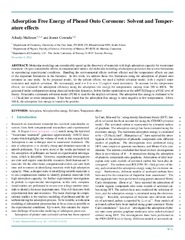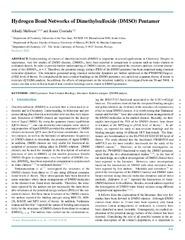Blar i forfatter "Conradie, Jeanet"
-
Adsorption free energy of phenol onto coronene: Solvent and temperature effects
Malloum, Alhadji; Conradie, Jeanet (Journal article; Tidsskriftartikkel; Peer reviewed, 2022-11-11)Molecular modeling can considerably speed up the discovery of materials with high adsorption capacity for wastewater treatment. Despite considerable efforts in computational studies, the molecular modeling of adsorption processes has several limitations in reproducing experimental conditions. Handling the environmental effects (solvent effects) and the temperature effects are part of the important ... -
Adsorption of some cationic dyes onto two models of graphene oxide
Mounra, Emma; Malloum, Alhadji; Fifen, Jean Jules; Conradie, Jeanet (Journal article; Tidsskriftartikkel; Peer reviewed, 2023-11-18)The search for highly efficient adsorbent materials remains a significant requirement in the field of adsorption for wastewater treatment. Computational study can highly contribute to the identification of efficient material. In this work, we propose a computational approach to study the adsorption of four cationic basic dyes, basic blue 26 (BB26), basic green 1 (BG1), basic yellow 2 (BY2), and basic ... -
B12 and F430 models: Metal- versus ligand-centered redox in cobalt and nickel tetradehydrocorrin derivatives
Ghosh, Abhik; Conradie, Jeanet (Journal article; Tidsskriftartikkel; Peer reviewed, 2023-03-23)DFT calculations with the well-tested OLYP and B3LYP* exchange-correlation functionals (along with D3 dispersion corrections and all-electron ZORA STO-TZ2P basis sets) and careful use of group theory have led to significant insights into the question of metal- versus ligand-centered redox in Co and Ni B,C-tetradehydrocorrin complexes. For the cationic complexes, both metals occur in their low-spin ... -
The Blue–Violet Color of Pentamethylbismuth: A Visible Spin-Orbit Effect
Conradie, Jeanet; Ghosh, Abhik (Journal article; Tidsskriftartikkel; Peer reviewed, 2016-12-22)Two-component relativistic time-dependent density functional theory calculations with spin-orbit coupling predict yellow and orange–red absorption for BiPh5 and BiMe5, respectively, providing an excellent explanation for their respective violet and blue–violet colors. According to the calculations, the visible absorption is clearly attributable to a single transition from a ligand-based HOMO ... -
Carbonyl Substitution in beta-Diketonatodicarbonyl-rhodium(I) by Cyclo-octadiene: Relationships with Experimental, Electronic and Calculated Parameters
Conradie, Jeanet (Journal article; Tidsskriftartikkel; Peer reviewed, 2013-01)The substitution rate constant of the reaction between [Rh(β-diketonato)(CO)<sub>2</sub>] and cyclo-octadiene is related to various empirical parameters and density functional theory calculated energies and charges, β-diketonato = R'COCHCOR. Results indicate that especially the Hammett meta substituent constants (σ), the Lever electronic parameters (EL) and the density functional theory calculated ... -
Comparing Isoelectronic, Quadruple-Bonded Metalloporphyrin and Metallocorrole Dimers: Scalar-Relativistic DFT Calculations Predict a > 1-eV Range for Ionization Potential and Electron Affinity
Conradie, Jeanet; Vazquez-Lima, Hugo; Alemayehu, Abraham; Ghosh, Abhik (Journal article; Tidsskriftartikkel; Peer reviewed, 2021-10-21)A scalar-relativistic DFT study of isoelectronic, quadruple-bonded Group 6 metalloporphyrins (M = Mo, W) and Group 7 metallocorroles (M = Tc, Re) has uncovered dramatic differences in ionization potential (IP) and electron affinity (EA) among the compounds. Thus, both the IPs and EAs of the corrole derivatives are 1 eV or more higher than those of the porphyrin derivatives. These differences ... -
Cyclic Voltammetric Study of 2-Hydroxybenzophenone (HBP) Derivatives and the Correspondent Change in the Orbital Energy Levels in Different Solvents
Adeniyi, Adebayo A.; Ngake, Tankiso L.; Conradie, Jeanet (Journal article; Tidsskriftartikkel; Peer reviewed, 2020-07-14)The experimental UV and CV of five substituted 2-hydroxybenzophenones in solvents acetonitrile, n-dimethylformamide and dimethylsulfoxide are presented. Results obtained were used to determine their experimental highest occupied molecular orbital (HOMO) and lowest unoccupied molecular orbital (LUMO) and the results were compared to their theoretical model. The derivatives with an electron withdrawing ... -
Data to Understand the Nature of Non-Covalent Interactions in the Thiophene Clusters
Malloum, Alhadji; Conradie, Jeanet (Journal article; Tidsskriftartikkel; Peer reviewed, 2022-01-10)We have reported herein the data to understand the nature and number of non-covalent interactions that stabilize the structures of the thiophene clusters. In addition, we have also provided the optimized Cartesian coordinates of all the structures of the investigated thiophene clusters. Initially, the geometries have been generated using the ABCluster code which performs a global optimization to ... -
DFT and electrochemical study on some iron(III) complexes with 2-hydroxybenzophenones
Chiyindiko, Emmie; Langner, Ernst H.G.; Conradie, Jeanet (Journal article; Tidsskriftartikkel; Peer reviewed, 2023-02-17)The synthesis, identification and electrochemical behaviour iron(III) complexes containing different 2-hydroxybenzophenone ligands are reported. The first reduction of the tris(2-hydroxybenzophenone)iron(III) complexes follow the same trend as that of the free, uncoordinated ligands and bis(2-hydroxybenzophenone)copper(II) complexes. The first reduction of the iron(III) complexes occur at a potential ... -
DFT benchmarking for adsorption energy in wastewater treatment
Malloum, Alhadji; Conradie, Jeanet (Journal article; Tidsskriftartikkel; Peer reviewed, 2023-07-31)Despite its potential importance, the computational chemistry of adsorption processes for wastewater treatment has received negligible attention. Exploring the literature shows several limitations in applying quantum chemistry to study adsorption processes in wastewater treatment. The choice of suitable functionals of density functional theory (DFT) is one of the critical limits of the current ... -
DFT studies of the redox behavior of oligo(aza)pyridines and experimental CVs of 4′-substituted terpyridines
Mateyise, Nandisiwe Ghandi Sibongile; Conradie, Marrigje M.; Conradie, Jeanet (Journal article; Tidsskriftartikkel; Peer reviewed, 2022-11-17)The cyclic voltammograms of a series of substituted terpyridine ligands are presented, showing that reduction occur generally below −2 V versus the redox potential of ferrocene. Density functional theory (DFT) calculated energies and the theoretically calculated reduction potentials of a large series of substituted oligo(aza)pyridine ligands (terpyridine, bipyridine and phenanthroline) are determined ... -
Dimethylsulfoxide (DMSO) Clusters Dataset: DFT Relative Energies, Non-Covalent Interactions, and Cartesian Coordinates
Malloum, Alhadji; Conradie, Jeanet (Journal article; Tidsskriftartikkel; Peer reviewed, 2022-03-07)Theoretical understanding of dimethylsulfoxide (DMSO) liquid depends on the understanding of the DMSO clusters. In this work, we provide the structures and the energetics of the DMSO clusters. The structures have been generated using ABCluster and further optimized at the MP2/aug-ccpVDZ level of theory. The final structures have been optimized at two different levels of theory: PW6B95D3/aug-ccpVDZ ... -
The Dog That Didn't Bark: A New Interpretation of Hypsoporphyrin Spectra and the Question of Hypsocorroles
Ghosh, Abhik; Conradie, Jeanet (Journal article; Tidsskriftartikkel; Peer reviewed, 2021-11-11)Nearly a half-century after Gouterman classified the UV–vis–NIR spectra of porphyrin derivatives as normal, hyper, or hypso, we propose a heretofore unsuspected “mechanism” underlying hypso spectra. Hypsoporphyrins, which exhibit blueshifted optical spectra relative to normal porphyrins (such as Zn porphyrins), typically involve dn transition metal ions, where n > 6. The spectral blueshifts have ... -
Electrochemical behaviour of 2-hydroxybenzophenones and related molecules
Chiyindiko, Emmie; Langner, Ernst H.G.; Conradie, Jeanet (Journal article; Tidsskriftartikkel; Peer reviewed, 2022-03-23)An electrochemical study, using cyclic voltammetry of 2-hydroxybenzophenone and related molecules, containing various electron withdrawing and/or electron donating groups, is presented. The CV profiles of the various molecules show one sharp reduction and one small oxidation wave, coupled to the reduction wave. Density functional theory (DFT) calculations shed light on the transmission of charges ... -
Electronic and structural data of 4’-substituted bis(2,2’;6’2’’-terpyridine)manganese in mono-, bis-, tris- and tetra-cationic states from DFT calculations
Conradie, Jeanet (Journal article; Tidsskriftartikkel, 2022-04-30)This data article provides density functional theory calculated structural (bond lengths and angles, coordinates of optimized geometries) and electronic (Mulliken spin population and character of frontier molecular orbitals) data of a series of 4’-substituted bis(2,2’;6’2’’-terpyridine)manganese complexes in four different oxidation states. The bis-cationic (n = 2) [Mn(tpy)<sub>2</sub>]<sup>2+</sup> ... -
Electronic effects on the mechanism of the NAD+ coenzyme reduction catalysed by a non-organometallic ruthenium(ii) polypyridyl amine complex in the presence of formate
Chrzanowska, Marta; Katafias, Anna; van Eldik, Rudi; Conradie, Jeanet (Journal article; Tidsskriftartikkel; Peer reviewed, 2022-08-01)In the present study, electronic effects on the mechanism of the NAD+ coenzyme reduction in the presence of formate, catalysed by a non-organometallic ruthenium(II) polypyridyl amine complex, were investigated. The [RuII(terpy)(ampy)Cl]Cl (terpy ¼ 2,20 :60 ,200-terpyridine, ampy ¼ 2-(aminomethyl)pyridine) complex was employed as the catalyst. The reactions were studied in a water/ethanol mixture ... -
Energetics of saddling versus ruffling in metalloporphyrins: Unusual ruffled dodecasubstituted porphyrins
Conradie, Jeanet; Ghosh, Abhik (Journal article; Tidsskriftartikkel; Peer reviewed, 2017-10-13)Presented herein is a first major density functional theory (BP86/D3/STO-TZ2P) survey of the energetics of saddling versus ruffling for a wide range of dodecasubstituted metalloporphyrins with M = Ni, Cu, Zn, Pd, and Pt. For the majority of X<sub>8</sub>TPP (i.e., β-octasubstituted-meso-tetraphenylporphyrin), the calculations indicated a clear preference for the saddled conformation, consistent with ... -
Free-Base Corrole Anion
Tarai, Arup; Mallick, Jyotiprakash; Conradie, Jeanet; Kar, Sanjib; Ghosh, Abhik (Journal article; Tidsskriftartikkel; Peer reviewed, 2023-08-30)Free-base corroles have long been known to be acidic, readily undergoing deprotonation by mild bases and in polar solvents. The conjugate base, however, has not been structurally characterized until now. Presented here is a first crystal structure of a freebase corrole anion, derived from tris(p-cyanophenyl)corrole, as the tetrabuylammonium salt. The low-temperature (100 K) structure reveals ... -
Gold dipyrrin-bisphenolates: A combined experimental and DFT study of metal-ligand interactions
Thomas, Kolle E; Desbois, Nicolas; Conradie, Jeanet; Teat, Simon J.; Gros, Claude P; Ghosh, Abhik (Journal article; Tidsskriftartikkel; Peer reviewed, 2020-01-02)Given that noninnocent and metalloradical-type electronic structures are ubiquitous among dipyrrin-bisphenolate (DPP) complexes, we synthesized the gold(III) derivatives as potentially innocent paradigms against which the properties of other metallo-DPP derivatives can be evaluated. Electronic absorption spectra, electrochemical studies, a single-crystal X-ray structure, and DFT calculations all ... -
Hydrogen bond networks of dimethylsulfoxide (DMSO) pentamer
Malloum, Alhadji; Conradie, Jeanet (Journal article; Tidsskriftartikkel; Peer reviewed, 2022-10-17)Understanding of clusters of dimethylsulfoxide (DMSO) is important in several applications in Chemistry. Despite its importance, very few studies of DMSO clusters, (DMSO)<i><sub>n</i></sub> , have been reported in comparison to systems such as water clusters or methanol clusters. In order to provide further understanding of DMSO clusters, we investigated the structures and non-covalent interactions ...


 English
English norsk
norsk


















